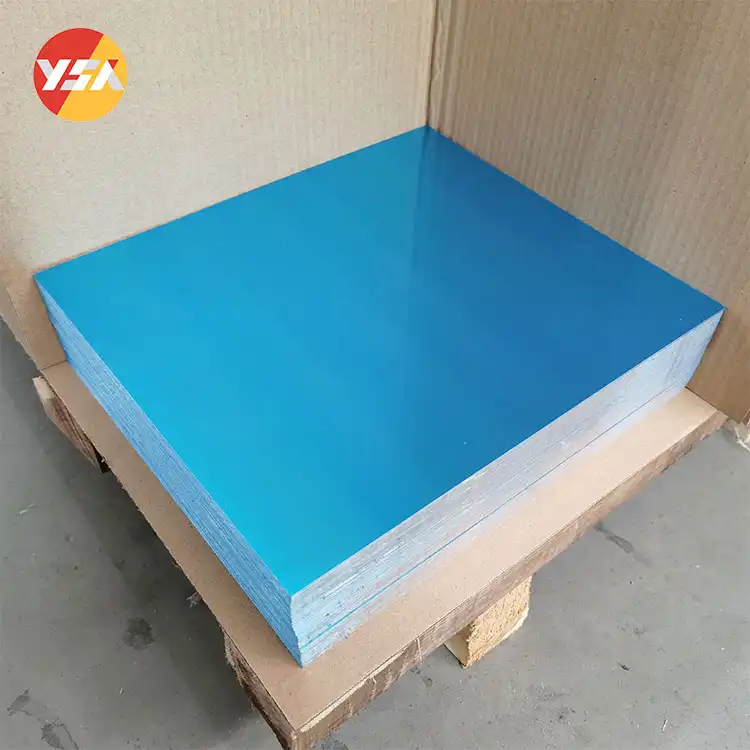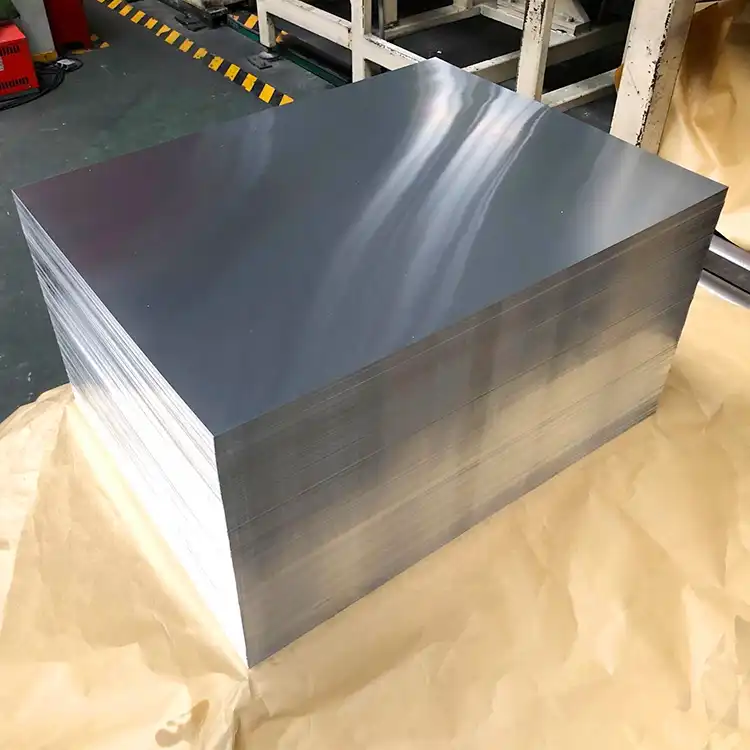What is 5086 Aluminum?
The aviation and maritime industries frequently utilize 5086 aluminum, an alloy valued for its exceptional strength and resistance to corrosion. It is a part of the aluminum alloys in the 5000 class, which are mainly made of magnesium. Magnesium enrichment gives the alloy more strength and better weldability. Because of its outstanding formability and machinability, aluminum 5086 can be used for a wide range of applications, such as shipbuilding, boat hulls, and aerospace structural components. It is perfect for maritime applications where corrosion resistance is essential since it is also resistant to saltwater and other severe environments.

The Properties of 5086 Aluminum
Physical Properties
| Property | Value |
| Alloy | 5086 |
| Temper | H32, H116, H321 |
| Density | 2.66 g/cm³ |
| Melting Point | 580-650°C |
Chemical Composition
| Element | Percentage (wt. %) |
| Magnesium | 3.5 – 4.5 |
| Manganese | 0.2 – 0.7 |
| Chromium | 0.05 – 0.25 |
| Iron | 0.0 – 0.5 |
| Silicon | 0.4 max |
| Copper | 0.1 max |
| Zinc | 0.25 max |
| Titanium | 0.15 max |
| Others | 0.15 max (each) |
| Aluminum | Balance |
Mechanical Properties
| Property | Value |
| Tensile Strength (Ultimate) | 240 MPa (35,000 psi) |
| Tensile Strength (Yield) | 140 MPa (20,000 psi) |
| Elongation at Break | 12% |
| Modulus of Elasticity | 69 GPa (10,000 ksi) |
| Shear Strength | 150 MPa (22,000 psi) |
| Hardness (Brinell) | 95 HB |
| Fatigue Strength | 70 MPa (10,000 psi) |
| Poisson’s Ratio | 0.33 |
| Thermal Conductivity | 127 W/m·K (74 BTU·in/hr·ft²·°F) |
| Electrical Conductivity | 34% IACS |
| Density | 2.66 g/cm³ |
5086 Aluminum Applications
- Marine Applications: 5086 aluminum is extensively used in the marine industry due to its exceptional resistance to corrosion, particularly in saltwater environments. It finds common application in boat hulls, decks, superstructures, and other components that require both high strength and corrosion resistance.
- Transportation Components: 5086 aluminum is employed in various transportation applications. It is utilized in the fabrication of truck and trailer bodies, as well as in the manufacturing of railway cars and their components. The alloy’s lightweight nature and corrosion resistance make it well-suited for these specific transportation applications.
- Architectural Applications: The appealing aesthetics, corrosion resistance, and ease of fabrication of 5086 aluminum make it suitable for architectural purposes. It is utilized in the construction of building facades, roofing systems, decorative elements, and other architectural features where its specific properties are advantageous.

What is the Difference between 5086 and 6061 Aluminum?
5086 and 6061 are both popular aluminum alloys, but they have some remarkable differences in their composition, properties, and applications. Here are the key distinctions between 5086 and 6061 aluminum.
Composition
- 5086 Aluminuim: Primarily composed of aluminum, magnesium, and small amounts of manganese, chromium, iron, silicon, copper, zinc, titanium, and other trace elements.
- 6061 Aluminum: Primarily composed of aluminum, magnesium, and silicon, with small amounts of copper, chromium, zinc, and other trace elements.
Properties
- Corrosion resistance: Both alloys show good corrosion resistance, but 5086 aluminum has superior resistance to saltwater and other harsh environments, making it a preferred choice for marine applications.
- Strength: 6061 aluminum has higher tensile strength than 5086 aluminum, making it suitable for uses where strength is a primary consideration.
- Formability: 5086 aluminum has better formability, allowing for easier shaping and fabrication compared to 6061 aluminum.
- Weldability: Both alloys can be welded, but 6061 aluminum has better weldability and is more generally used in welding applications.

Applications
- 5086 Aluminum: It is generally applied in marine and shipbuilding uses, such as boat hulls, decks, and superstructures, owing to its excellent corrosion resistance. It is also used in chemical storage tanks, cryogenic tanks, and other uses needing high corrosion resistance.
- 6061 Aluminum: It finds wide use in a many kinds of applications, including structural components, frames, and parts for aerospace, automotive, and general engineering industries. It is also generally used in construction, such as in architectural elements, bicycle frames, and electrical fittings.
What is the Difference between 5052 and 5086 Aluminum?
5052 and 5086 are two commonly used aluminum alloys, and while they share some similarities, they also have distinct differences. Here are the key differences between 5052 and 5086 aluminum.
Composition
- 5052 aluminum: Primarily composed of aluminum, magnesium, and small amounts of chromium, iron, silicon, copper, manganese, and other trace elements.
- 5086 aluminum: Primarily composed of aluminum, magnesium, and small amounts of manganese, chromium, iron, silicon, copper, zinc, titanium, and other trace elements.
Properties
- Corrosion resistance: Both alloys offer good corrosion resistance, but 5086 aluminum has superior resistance to saltwater and other corrosive environments, making it a preferred choice for marine applications.
- Strength: 5086 aluminum has higher tensile strength and yield strength compared to 5052 aluminum, making it stronger and more suitable for applications where strength is a critical factor.
- Formability: 5052 aluminum has better formability, allowing for easier shaping and fabrication compared to 5086 aluminum.
- Weldability: Both alloys can be welded, but 5052 aluminum has better weldability and is more commonly used in welding applications.

Applications
- 5052 aluminum: It is commonly used in general sheet metal fabrication, automotive components, fuel tanks, and electrical enclosures due to its good formability, corrosion resistance, and moderate strength.
- 5086 aluminum: It is primarily utilized in marine and shipbuilding applications, such as boat hulls, decks, and superstructures, thanks to its excellent corrosion resistance, high strength, and resistance to saltwater environments. It is also used in chemical storage tanks, cryogenic tanks, and other applications requiring high corrosion resistance.
What is the difference between 5083 and 5086 Aluminum?
5083 and 5086 are both marine-grade aluminum alloys that provide fantastic anti-rust characteristic, but there are some key differences between them. Here are the main distinctions between 5083 and 5086 aluminum。
Composition
- 5083 aluminum: Mainly composed of aluminum, magnesium, and small amounts of manganese, chromium, iron, silicon, copper, zinc, titanium, and other trace elements.
- 5086 aluminum: Mainly composed of aluminum, magnesium, and small amounts of manganese, chromium, iron, silicon, copper, zinc, titanium, and other trace elements.
Properties
- Corrosion resistance: Both alloys are highly corrosion resistant, especially in marine environments. Nevertheless, 5083 aluminum has slightly better resistance to saltwater and other corrosive environments, making it more appropriative for marine uses.
- Strength: 5083 aluminum has higher tensile strength and yield strength compared to 5086 aluminum, making it stronger and more suitable for uses where strength is a important factor.
- Formability: 5086 aluminum has better formability, allowing for easier shaping and fabrication compared to 5083 aluminum.
- Weldability: Both alloys can be welded, but 5086 aluminum has better weldability and is more generally applied in welding uses.

Applications
- 5083 aluminum: Because of its exceptional corrosion resistance, high strength, and ability to withstand saltwater environments, this aluminum is mostly utilized in marine and shipbuilding applications, such as boat hulls, decks, and superstructures. In addition, cryogenic storage tanks and other uses where strong corrosion resistance is required employ it.
- 5086 aluminum: Like 5083 aluminum, 5086 aluminum is also frequently used in maritime and shipbuilding applications because of its favorable corrosion resistance, strength, and weldability. It is also utilized in pressure vessels, chemical storage tanks, and other applications where a high level of corrosion resistance is required.
Summary
In conclusion, with its exceptional corrosion resistance, high strength, and weldability, 5086 aluminum finds extensive use in marine applications, including boat hulls, decks, and superstructures. We delve into its chemical composition, physical and mechanical properties, highlighting its formability and machinability. Moreover, we showcase its relevance in aerospace, chemical storage, industrial equipment, and architectural applications. Overall, 5086 aluminum is an alloy that performs well in challenging environments.

FAQ
Can you weld 5086 Aluminum?
Yes, 5086 aluminum can be welded. It has good weldability, and various welding methods like TIG (tungsten inert gas) welding, MIG (metal inert gas) welding, and resistance welding can be used to join 5086 aluminum. However, it is important to choose the appropriate filler material and welding parameters to ensure a successful weld.
Can you bend 5086 Aluminum?
5086 aluminum can also be bent. It offers good formability, allowing for easy bending and shaping. However, it is worth noting that the exact bending properties may vary depending on the temper of the 5086 aluminum alloy.
Can you weld 5086 to 6061?
As for welding 5086 to 6061 aluminum, it is technically possible to weld these two alloys together using appropriate welding techniques and compatible filler materials. However, it is important to consider the differences in their properties, such as strength and composition, which can affect the weld joint’s integrity and performance. Consulting with a qualified welding professional or referring to specific welding guidelines is recommended to ensure a successful and reliable weld between 5086 and 6061 aluminum.


